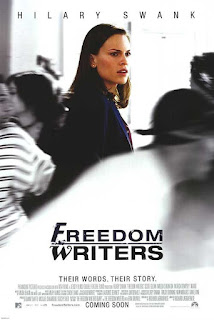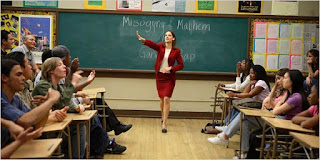
Film name Freedom Writers
Year 2007
Country United state
Filming Locations Los Angeles, California, USA
Director Richard LaGravenese
Language English
Accent American English
Written by Erin Gruwell
Cast:
Hilary Swank as Erin Gruwell
Scott Glenn as Steve Gruwell
Patrick Dempsey as Scott Casey
Imelda Staunton as Margaret Campbell
April Lee Hernández as Eva Benitez
Mario as Andre Bryant
Kristin Herrera as Gloria
Jaclyn Ngan as Sindy
Sergio Montalvo as Alejandro Santiago
Jason Finn as Marcus
Deance Wyatt as Jamal Hill
Vanetta Smith as Brandy
Gabriel Chavarria as Tito
Hunter Parrish as Ben
Antonio García as Miguel
Giovonnie Samuels as Victoria
John Benjamin Hickey as Brian Gelford
Robert Wisdom as Dr. Carl Cohn
Pat Carroll as Miep Gies
Will Morales as Paco
Main character:

Plot: Fresh–faced, idealistic twenty–three–year–old Erin Gruwell is ready to take on the world as she steps inside Wilson High School for her first day of teaching. Her class, a diverse group of racially charged teenagers from different walks of life African Americans, Latinos, Asians, juvenile delinquents, gang members, and underprivileged students from poor neighborhoods hope for nothing more than to make it through the day. Despite her students’ obstinate refusal to participate during class, Erin tries various means to engage them on a daily basis.
They spark a transformation in the classroom, compel them to listen
and force her to take off her idealistic blinders and take in the kids’ survival stories of their undeclared war on the streets. Erin begins to connect with them. She brings in music from the ‘Hood, and literature from another kind of ghetto, The Diary of Anne Frank, and with these simple tools she op
ens her students’ eyes to the experiences of those suffering intolerance throughout the world and the struggles of those outside their own communities. Knowing that every one of her students has a story to tell, Erin encourages them to keep a daily journal of their thoughts and experiences.
After sharing their stories with one another, the students see their shared experience for the first time and open up to the idea that there are possibilities in life outside of making it to the age of eighteen.
Taken from http://uk.hollywood.com/films/freewrite.fhtml

Context:
African-American neighborhoods or black neighborhoods are types of ethic enclaves found in many cities in the United States. Generally, an African American neighborhood is one where the majority of the people who live there are African American. Some of the earliest African American neighborhoods were in New York City. There were also early communities in Virginia. In 1830, there were 14,000 "free Negroes" living in New York City. They had their own schools and churches. The formation of black neighborhoods is closely linked to the history of segregation in the United States, either through formal laws, or as a product of social norms. Despite this, black neighborhoods have played an important role in the development of nearly all aspects of both African-American culture and American culture.
Racial segregation in the United States has meant the physical separation and provision of separate facilities (especially during the Jim Crow era), but it can also refer to other manifestations of racial discrimination such as separation of roles within an institution, such as the United States Armed Forces up to 1948 when black units were typically separated from white units but were led by white officers.
Powerful ideas and Values:
· Effort
· Optimism
· Perseverance
· Comradeship
· Teamwork
· Envy
· Ideals
· Discrimination
· Segregation
· Racism
Personal opinion:

As future teacher, I think Miss Erin Gruwell in her role represents the dream of any teacher when we have to face with a complicated class, but I do not know if the cost that she paid, I would be able to assume like she did (losing her husband in order to achieve her goals).
I liked so much how she managed the lack of interest of her students, because the strategies that she used even though they were exaggerated in the film, they are not far from what many authors recommend as good in a classroom, I noticed that the most frequently used strategy was to make a significant lesson which also she adapted to the students’ context. From my opinion it is a strategy that we can perform in any classroom of our country.
Another important point in the film is the teacher’s effort and perseverance, for achieving the students’ respect who finally accepted her part of their family (in a hypothetical way). Unfortunately, this reality is not very common in the Chilean’s classrooms, because the Chilean teachers are not very respected, excepting some cases. However, this is our goal, “to change this perspective with the same spirit that the protagonist had”.
















